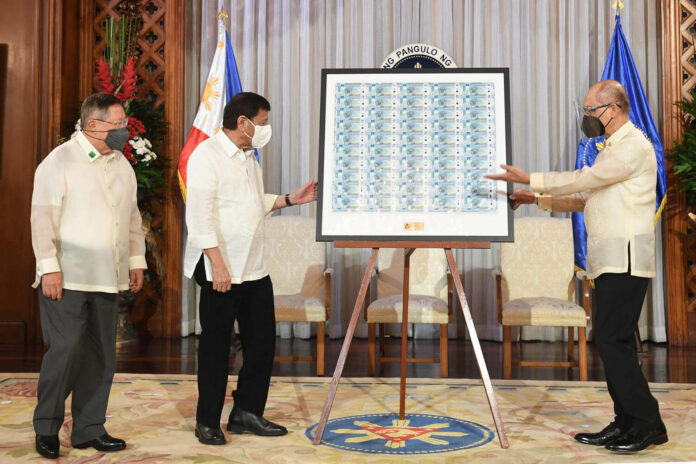
There will be new banknotes for the Philippines. In April 2022, the Bangko Sentral ng Pilipinas (BSP) unveiled a 1000 piso banknote to open the new series. But the new banknotes are quite controversial and illustrate that money is not merely a means of payment – it reflects the self-image of a country and its people.

The Philippine’s Resistance
To understand the current discussion, we need to take a brief look at the past. As early as in 1898, the Philippine’s issued its declaration of independence from Spain’s colonial forces. However, nobody recognized the new state. On the contrary: the US occupied the Philippines and only wanted to gradually release the country into independence at a later time.
In World War II, the Philippines fought with the US on the side of the Allies and was occupied by Japan. This period between 1942 and 1945 was characterised by numerous atrocities and is still part of the country’s collective memory. It was not until 1946 that the Philippines became an internationally-recognised state.
In the 1970s, President Marcos established a dictatorship, against which the people took to the streets in the 80s. Civil resistance successfully put an end to Marcos’ autocracy and, in 1987, a new constitution led to a new beginning in the form of a presidential republic. All these events had an impact on the country’s banknotes and dominate today’s discussions.

A New Era
As of 1985, the BSP issued a new banknote series, coinciding with the popular revolt against Marcos. Initially, the New Design Series did not have a political agenda. After the fall of the dictator, however, the brand new 500 piso banknote was replaced by a new one depicting Benigno Arquino Jr, who had been assassinated in 1983 and was a leading figure of the democracy movement. In 1991, the highest denomination was finally issued, the 1000 piso note featuring three famous resistance fighters of World War II: José Abad Santos, Josefa Llanes Escoda and Vicente Lim. All three of them had been assasinated by Japanese occupiers. Since then, this banknote has been produced without any changes.
In 2009, the BSP announced a new banknote series. They wanted to produce polymer banknotes featuring new motifs. But when the New Generation Currency Series was launched in 2010, the three war heroes remained on 1000 piso banknotes that were still printed on paper.
In the fall of 2021, the BSP again announced that new polymer banknotes would be introduced, starting with the 1000 piso banknote. The notes were to meet the latest standards including advanced anti-counterfeit features, were said to be easier to disinfect (an aspect that was quite characteristic for the peak of the Covid pandemic) and should also get an aesthetic makeover.

Bananas and Identity
This triggered two discussions. First, it is important to know that the Philippines is home to the abacá, a species of banana that is used for industrial purposes. Its fibers are used to produce teabags or paper – and Filipino banknotes. That’s why the BSP is now talking with representatives of the abacá industry, which appears to be significantly affected by the decision to produce polymer banknotes.
Unfortunately, the central bank did not consult anyone regarding the second issue: the change in motif. The obverse no longer features the three heroes but the Philippine eagle. According to the BSP, the eagle “symbolizes clear vision, freedom, and strength”, the reverse motif was not altered and still depicts the Tubbataha Reefs Natural Park.
According to the Inquirer.net newspaper, Desiree Benipayo, the great-grandniece of the World War II hero Abad Santos, said the new motifs were “very telling [of] how this government treats our heroes and martyrs”.

The University of the Philippines’ Department of History also felt compelled to comment on the BSP’s decision. ABS CBN News quotes the historians as follows: “It appears by this act, the BSP is not only disregarding the Filipino symbol of its quest for nationhood and what it means through these heroes; the BSP is also trivializing this symbol.” It was a “slap in the face” of the three heroes, they said. Moreover, “the central bank should have carried out a public consultation.” The historians also mentioned that just one 1000 piso note was introduced without Filipino heroes or public consultation in the last century: the banknote of the hated Japanese occupiers. These banknotes are still contemptuously called “Mickey Mouse” issues today …
The National Historical Commission also criticised that they had not been consulted on the changes. The BSP’s reaction on this criticism is quite revealing: “[T]he BSP said it did not need to. Since the bill featured an animal, the central bank said it consulted the Department of Environment and Natural Resources”, ABS CBN News reported.
The Power of Banknotes
With this statement, the central bank downgrades the role of its own money. Will flora and fauna be enough to build a national identity in a multi-ethnic state with a history that has many fractures? The Philippines is in good company with its new banknote motif: numerous countries such as South Africa, Fiji and New Zealand focus on harmless nature themes. And European countries, too, opted with the introduction of the Euro for neutral, abstract architectural motifs on their banknotes in order to avoid discussions. At least the European Central Bank has now realised that these motifs do not stir emotions and do not help to promote a European identity. New banknotes are currently being created – but only after a public consultation.
The topic was covered by Inquirer.net and ABS CBN News.
We reported on the ECB announcing new euro banknotes.
Fiji has been celebrating its flora and fauna on banknotes since 2012.
Is it true that polymer banknotes are much more resistant than other banknotes? In 2020 it became known that Great Britain had to replace a surprising number of £5 and £10 banknotes.



